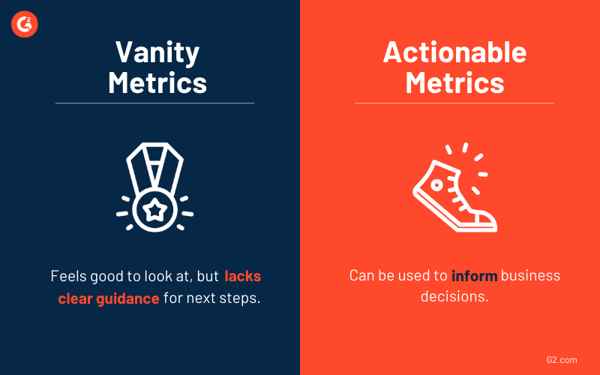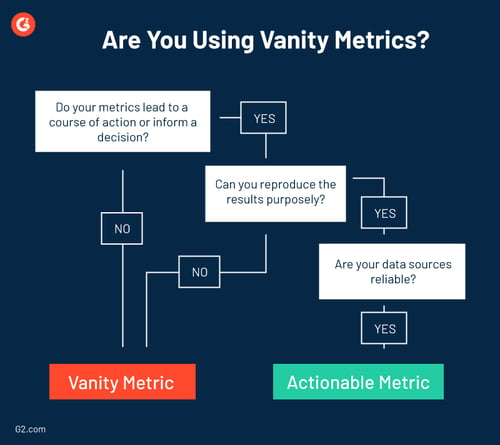

Vanity is vain.
Weighing your content performance is an art of selection. Splitting the difference between useful data and runny numbers is crucial.
The actions you and your team make every day should aim to achieve the goals you set for your department and the overall company goals. There is an abundance of marketing metrics that can be tracked and reported to your manager to show off your success.
Investing your time in futile metrics might be time-laundering, but it surely sets you on the right road. Finding the right metrics with social media analytics software can help you reach your goals. But how? Let's find our way through the hyped hogwash of vanity.
Vanity metrics are data points that appear impressive to others but do not inform future strategies or present success. These numbers are easy to manipulate, purposely or unintentionally, making it easy to imply success without actually being meaningful results regarding the overall goal.
If you’re a marketer, it’s your job to see beyond the big and impressive-looking numbers and pull out the actionable insights.
Vanity metrics are the numbers that are measured and may look great to others but don’t ultimately contribute to an overall understanding of performance or help influence future decision-making or strategy.
One of the easiest mistakes a marketer can make is to take the time to track and report vanity metrics. Even though they don’t play an enormous role in the success of the department or company, the vanity metric graphs that constantly reflect an upward trend can be tempting to believe and rely on. But this doesn’t mean that they should be relied upon.
There is no definite list of vanity metrics for your team to avoid, because any metric can be a vanity metric. It all depends on the stage of your business, the goals your team has set, and additional circumstances.
For example, a startup with a goal of gaining exposure might want to measure the increase in the number of followers they have on social media because that number indicates an increase in brand awareness. On the other hand, a fifty-year-old business may be more focused on the number of followers who convert into customers, making their number of followers on social media less meaningful.
If you published a blog and wish to acquire more visitors, A/B testing is an important metric to track. In this context, keyword numbers, link numbers or technical seo metrics might be close to vanity metrics, since they do not attract visitors directly.
It should be noted that vanity metrics are not meaningless. You’ll notice that the number of followers is still needed by the fifty-year-old business in order to convert an attainable share. Vanity metrics just aren’t the numbers that should be published in the report that you hand to your manager.
Newcomers in marketing find it hard to draw the line between the "surface level" impact and "root" impact.

Vanity metrics are notorious for being somewhat basic and often misleading. These metrics are gaudy and rosy to look at, but often translate into no business. They are not key performance indicators of a brand's success, and do not aid in bottom line.
Actionable metrics are those that you and your team can improve by taking action, while vanity metrics often grow without you needing to do much of anything at all. These metrics are structured, quantified and aligned across each functional branch to follow and analyze.
Note: While vanity metrics can be shallow, they’re still necessary to keep track of in order to calculate the more actionable metrics. Marketing automation software is capable of doing those calculations for you, so long as you know which metrics are important in regards to your goals.
Again, every business has different goals, so it’s crucial that you remind yourself what are you working towards and present impact of your efforts.
Vanity metrics for one company may be considered actionable for another. In order to determine whether or not your team is spending too much time tracking metrics that don’t matter as much as others might, the first step to do is ensure that you’re creating marketing objectives that are SMART: specific, measurable, achievable, relevant, and time-based.
While this method is helpful for avoiding the measurement of vanity metrics, it isn’t foolproof. As you’re setting SMART goals, be sure to also keep the following in mind.

It’s not always easy to decide which metrics to report, especially when you know some of those numbers will look great to your manager. In order to be completely transparent, the first question you should ask yourself is whether or not the metrics you’re measuring and reporting can help lead to a course of action or make a decision.
If the metric you’re considering doesn’t help accomplish either of those things, then it might be best to pocket it. The metrics that answer this question with a “no” aren’t ones that are actionable. While they may become part of an equation to determine other, more actionable metrics, these vanity metrics shouldn’t be reported alone.
An example of this would be taking the time to measure and report the number of visitors your article is receiving. This number alone doesn’t encourage any decisions or actions, but taking note of where those views are coming from can help you figure out how to better balance your promotion strategy.
Sometimes, traffic spikes because of a great SEO team. Sometimes it’s because Kim Kardashian shared your article on Twitter.
Do you have some control over the metrics that you’re reporting? If not, think twice about presenting it – it may not be worthwhile. If the spikes in your graphs are due to luck (or Kim Kardashian), it’s unlikely that you’ll be able to recreate that result next quarter. If the results you see can’t be repeated, they’re not dependable enough to be the variables that your team takes into consideration to improve those results in the future.
Dirty data is out there, and it might be closer than you think. Some data can be easily manipulated to make results appear more impressive than they would be if they had not been taken advantage of in the first place.
If the source of your data is one that can be easily manipulated, such as purposely buying followers or accidentally acquiring a few bots or fake follower accounts, the number of followers you have is a vanity metric.
Additionally, inconsistent sources of data, such as a surge of sales during the holidays, are vanity metrics on their own. Instead, keep an eye on these metrics and point them out when you’re reporting overall metrics such as total sales over the course of a year. Just because a metric is a vanity metric doesn’t mean it should be completely disregarded.
If you’re worried that you and your team haven’t been tracking success to the best of your abilities, fear not. It’s never too late to start measuring something new.
Below, we’ll go over a few examples of the vanity metrics that marketers commonly take the time to measure. These metrics aren’t necessarily bad, but marketers can do better by digging deeper into their data and finding the metrics that they can take action to improve upon, as opposed to the ones that emerge without much work taking place.
When you walked into your office on Monday morning, you found out that 50 people downloaded your infographic over the weekend. That’s a pretty nice number over just a two day period, and it’s going to look great on your report.
But is that number as significant as you think it is?
| Vanity Metric | Actionable Metric | Why This Works |
| Number of conversions | Conversion rate | Percentages are often more revealing than hard numbers. |
Number of conversions is considered a vanity metric because there isn’t much work that can be done to encourage that specific number. Instead, take the time to track the conversion rate.
Over the course of a month, 43,000 people visited the landing page that housed that infographic, and, for whatever reason, the only time people downloaded it was that weekend.
That’s a conversion rate of .16%.

That number is much more indicative of the efforts put into that downloadable asset, the design of the landing page, and the overall distribution amongst other content and on social media. Not only is that number showing what your team’s current efforts are doing for your content, but it can help you take the time to sit down and determine where things can be improved.
In the beginning, it can be exciting to watch the number of followers on your social media platforms spike. But that number can be easily manipulated – influencers and companies can even buy followers or bots to stack onto that number to make it appear more impressive than it is.
| Vanity Metric | Actionable Metric | Why This Works |
| Number of social followers | Engagement rate | Percentages are often more revealing than hard numbers. |
Instead of measuring the number of followers, which could grow whether or not you show up to work, report on metrics that lead to the bigger picture. For example, how many of those followers are actually engaging with the content you post? Are those that are engaging taking the next step to click through? Are those followers people who are already customers? Are they converting into customers? Answers to these questions are going to be much more effective at pointing you and your team to the next steps you should be taking.
Although it likely shouldn’t appear in a report, the number of followers isn’t unimportant. In fact, tracking that number is necessary in order to measure the actionable metrics above. Your social media presence can have a huge impact on your business, but tracking the number of followers alone isn’t going to tell you what that impact is.
While some of the above vanity metrics may bounce up and down on a graph, the number of page views is a metric that only goes up. It’s impossible to decrease the number of views a page receives in total, meaning that every month, your numbers will grow larger and look even more flashy than they did the month before.
That number doesn’t mean very much on its own.
| Vanity Metric | Actionable Metric | Why This Works |
| Number of page views | Bounce rate | Shows how many of your visitors stay on your site versus those who stumble off of it. |
Without any context, that number only proves that people are seeing your content. Take a step or two further: how many of those visitors are continuing to other pages of your website versus those who bounce? The lower your bounce rate, the more engaging your content is. This number can be improved upon by interlinking more relevant content, creating enticing calls-to-action, and so on.

Other actionable metrics that will tell you and your managers more about your site’s performance include the total time spent on your page, the number of unique users, and the average number of pages per session.
Any metric that focuses more on the behavior and quality of those visitors, rather than the sheer number of visitors can help you and your team determine what you’re doing right and what can be improved upon.
Reporting your subscriber growth rate to your team in a weekly meeting can help colleagues get a better understanding of how many people are choosing to opt in to view their content. While that rate can move up and down, any number other than zero is a good sign that growth is happening.
But, as we’ve learned with past vanity metrics, bigger isn’t always better.
| Vanity Metric | Actionable Metric | Why This Works |
| Number of email subscribers | Acquisition path | Indicates which pages have high conversion rates as well as what content subscribers may be interested in reading in the future. |
Instead of tracking the growth rate of your subscriber list, track something that you can actually take action on. For example, taking note of the acquisition path that subscribers take can indicate which content is most interesting to them. Knowing this information could help you and your team build out more curated campaigns that will yield more success.
Taking note of the pages where readers convert into subscribers can also call for a comparison of those successful pages to the ones that aren’t converting as well. What makes one page more successful than another? Determining answers and taking the time to test out new ideas is just one example of the action that this metric calls for.
Now that we’ve gone over some examples and how to determine which metrics to avoid reporting to your manager, how do you know which metrics are worth your time?
As a business grows from one employee to one hundred, the metrics that were measured on day one are much less relevant now. It’s important to note that metrics can be actionable at one stage of a business’s existence, but they can slowly turn into vanity metrics as growth occurs.
For example, when a business is just starting up, not many people know about it. A goal that the marketing team might set would be to establish a stable presence in their industry. Ways that this could be measured include the amount of traffic their website is receiving, the amount of social media followers they earn, reviews on other sites, and the number of email subscribers they have.
But as that company begins to make a name for itself, it’s time for marketers to focus on other areas of growth. Instead of measuring the amount of visitors that come to their website, they might consider taking a look at how much time those visitors are spending on the site and whether they bounce. Instead of tracking their email subscriber count, they might want to begin watching their conversion rate from their emails to their website, and how those conversions impact revenue.
There’s plenty of data to choose from when it comes to reporting the success your team is having. The problem is that if your team isn’t successful, there are still ways to make it appear otherwise. But choosing to report vanity metrics is like putting a bandaid over a bullet hole.
Whether your team is absolutely crushing it or is having a bit of a struggle to hit their goals, it’s important to report the results of their work accurately and honestly. Actionable metrics might be more difficult to measure and a little harder to look at, but they’re the key to knowing what steps need to be taken in order to improve.
Blast your content with sure-shot success by reading this inquisitive list of `10 social media metrics to increase brand visibility.

Discover what results your social media marketing efforts bring by using advanced dashboards and tracking actionable metrics with social media analytics software.
Daniella Alscher is a Brand Designer for G2. When she's not reading or writing, she's spending time with her dog, watching a true crime documentary on Netflix, or trying to learn something completely new. (she/her/hers)

Discover what results your social media marketing efforts bring by using advanced dashboards and tracking actionable metrics with social media analytics software.
Any smart marketer knows that creativity is just half of the job. The other half? Measuring...
 by Daniella Alscher
by Daniella Alscher
The first page of the marketing bible reads: “measure your KPIs”.
 by Daniella Alscher
by Daniella Alscher
The more data we collect about our marketing activities, the more doors can open to lead us to...
 by Daniella Alscher
by Daniella Alscher
Any smart marketer knows that creativity is just half of the job. The other half? Measuring...
 by Daniella Alscher
by Daniella Alscher
The first page of the marketing bible reads: “measure your KPIs”.
 by Daniella Alscher
by Daniella Alscher
Never miss a post.
Subscribe to keep your fingers on the tech pulse.


